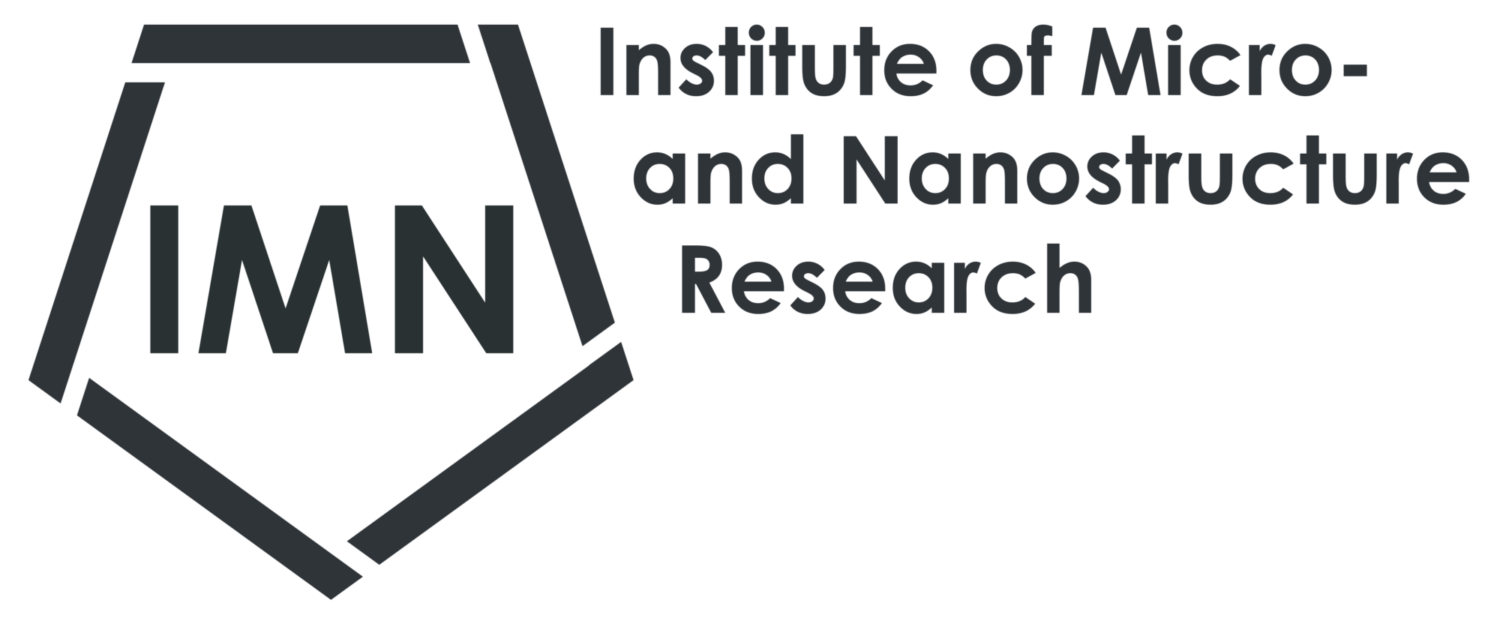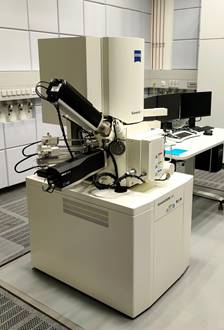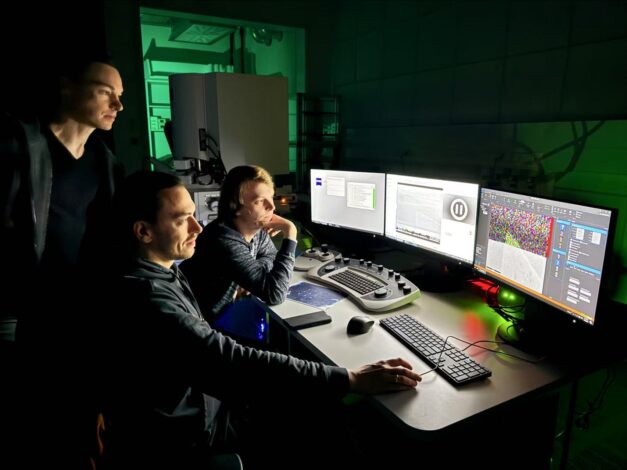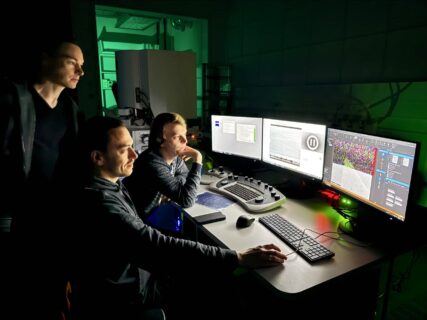Facilities
Facilities
The Institute of Micro- and Nanostructure Research runs the user facility of the Center for Nanoanalysis and Electron Microscopy (CENEM), which includes the following instruments:
- three transmission electron microscopes (TEM) with various TEM specimen holders,
- a scanning electron microscope / focused ion beam SEM/FIB Dualbeam system,
- a tabletop SEM,
- a lab-based X-ray microscope (Nano-CT) and
- broadly equipped sample preparation and materials processing laboratories.
With the expertise of the staff and the equipment cutting-edge research can be performed in a wide field of electron and X-ray microscopy. Detailed information about the various instruments, their accessories and the sample preparation can be found below.
FEI Titan Themis3 300
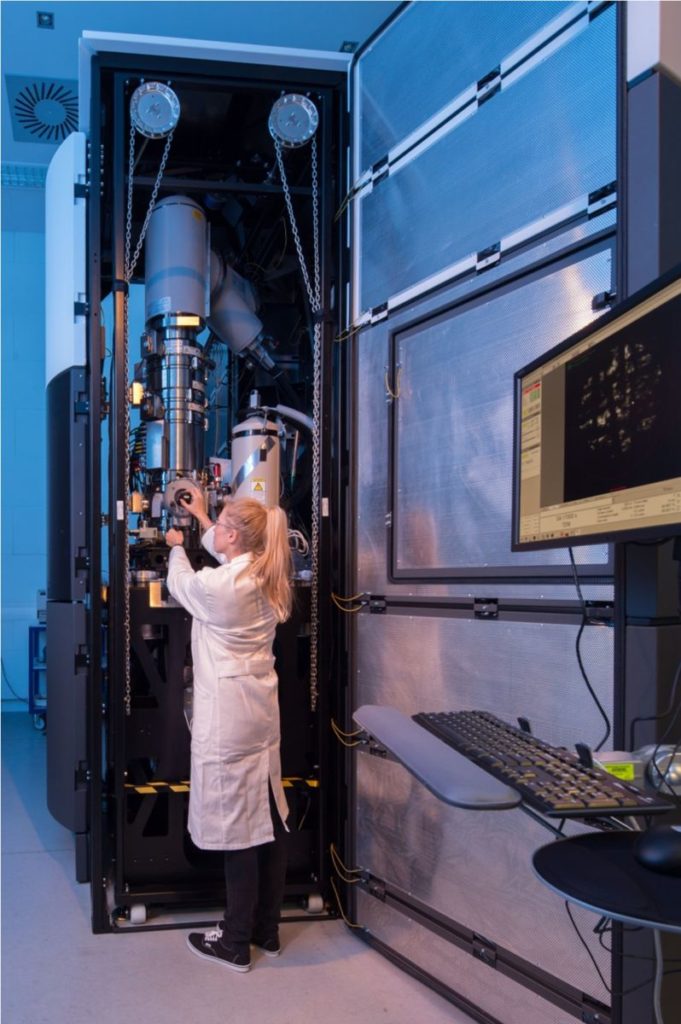
The Titan Themis3 300 is one of our two high-end TEM providing high-resolution imaging as well as high performance analytical investigation capabilities. This double-aberration-corrected TEM corrects both the image and the probe forming system enabling high-resolution imaging in TEM as well as scanning TEM (STEM) mode resulting in resolution limits below 1 Å for both modes for all high tensions between 60 kV and 300 kV. The high brightness electron gun (X-FEG) equipped with a monochromator to improve the energy resolution in combination with a high-sensitivity SDD X-ray spectrometer (Super-X) and a high-resolution post-column energy filter (GIF Quantum) creates a high performance analytical instrument perfectly suited for the nanoanalytical characterization of all kinds of materials and devices. Energy filtered TEM (EFTEM) imaging, high-resolution electron energy-loss spectroscopy (EELS) as well as energy-dispersive X-ray spectroscopy (EDXS) yield chemical, elemental as well as bonding information even down to the atomic scale. Additionally information about local band gaps and plasmonics are gained by monochromated low-loss EELS investigations. Furthermore, the Titan Themis3 300 is used to perform advanced in situ experiments using special TEM specimen holders. A further advanced method available at the Titan Themis3 300 is electron tomography enabling the analytical characterization of materials and devices in 3 dimensions. This high-end analytical TEM is used to answer the most complex questions regarding materials science.
- Emitter X-FEG
- High tension: 60-300 kV
- Monochromator, energy resolution 0.2 eV
- Cs probe corrector (CEOS, DCOR)
- Image-side Cs corrector (CEOS, CESCOR)
- Gatan imaging filter (GIF Quantum)
- HAADF detector for Z-contrast (Fishione)
- ADF/ABF/BF detectors (FEI)
- Videocamera (Flucam)
- 4k CMOS camera (Ceta 16M)
- High-efficiency Super-X detector (EDX)
- Tomography sample holder and software
- Special TEM holders (see below)
Supervisors:
| Dr. Mingjian Wu | Phone number: +49 9131 85-70394 | Email: mingjian.wu@fau.de | |
| Dr. Benjamin Apeleo-Zubiri, Akad. Rat | Phone number: +49 9131 85-70394 | Email: benjamin.apeleo.zubiri@fau.de | Website: http://www.em.techfak.uni-erlangen.de |
Thermo Fisher Scientific Spectra 200 C-FEG
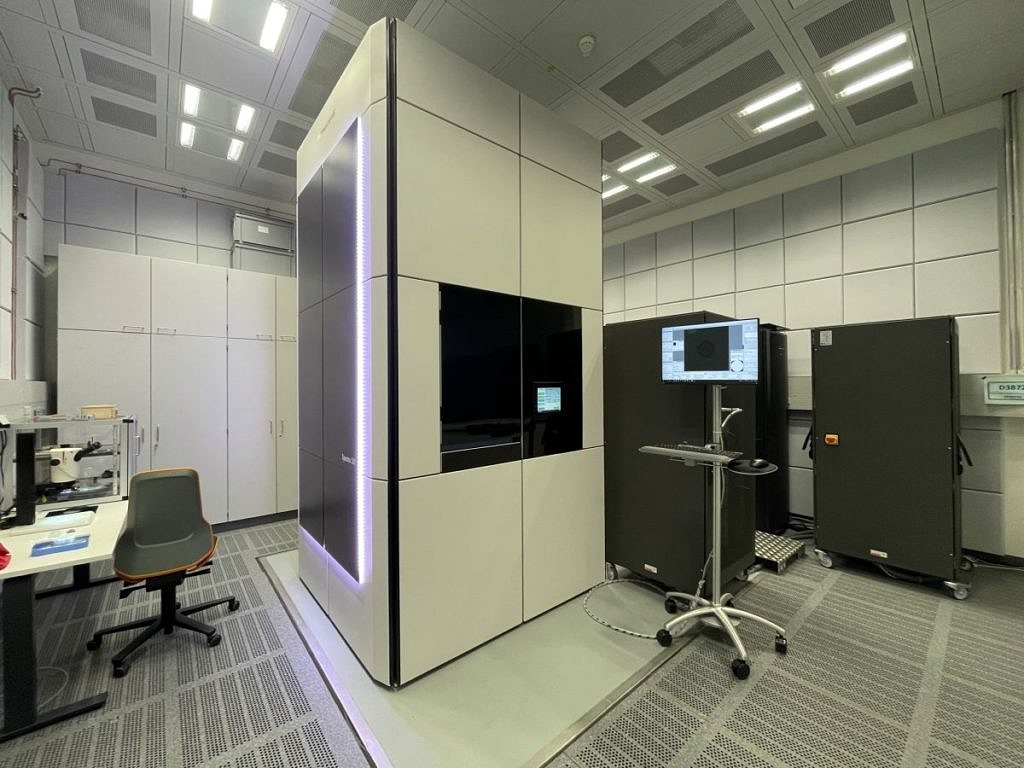
The Spectra 200 provides high-resolution imaging as well as high-performance analytical investigation capabilities. This probe-corrected TEM enables high-resolution imaging in scanning TEM (STEM) mode for all high tensions between 30 kV and 200 kV. The ultra-high-brightness cold field emission gun (X-CFEG) with an energy resolution of < 0.4 eV in combination with a high-sensitivity SDD X-ray spectrometer (Super-X) and a high-resolution post-column energy loss spectrometer (Gatan Continuum S) creates a high-performance analytical instrument perfectly suited for the nanoanalytical characterization of all kinds of materials and devices. High-resolution electron energy-loss spectroscopy (EELS) as well as energy-dispersive X-ray spectroscopy (EDXS) yield chemical, elemental as well as bonding information even down to the atomic scale. Furthermore, the Spectra with its Ceta-S 4k high speed CMOS camera (up to 400 fps at binning 512) is used to perform advanced in situ experiments by making use of special TEM specimen holders available at CENEM. Moreover, in combination with simultaneous STEM imaging, the Spectra 200 allows for 4D-STEM investigations. A further advanced method available at the Spectra 200 is electron tomography enabling the analytical characterization of materials in three dimensions. This high-end analytical TEM enables to answer the most complex questions in almost all discipline of materials science and nanotechnology.
The most important specifications of the TFS Spectra 200 are:
- X-CFEG emitter
- High tension: 30-200kV
- Energy resolution < 0.4 eV
- Probe Cs corrector (CEOS S-CORR)
- Point resolution for STEM: 60 pm @ 200 kV, 125 pm @ 30 kV
- Gatan spectrometer (Gatan Continuum S)
- Super-X detector G2 (EDXS)
- BF, ADF STEM and iDPC imaging: 8 segmented BF and ADF detectors (16 segments in total)
- 4k CMOS camera
- Electron tomography functionality (including EDXS)
Supervisors:
| Dr. Tadahiro Yokosawa | Phone number: +49 9131 85-70403 | Email: tadahiro.yokosawa@fau.de | Website: http://www.em.techfak.uni-erlangen.de |
| Dr. Mingjian Wu | Phone number: +49 9131 85-70394 | Email: mingjian.wu@fau.de | |
| Dr. Benjamin Apeleo-Zubiri, Akad. Rat | Phone number: +49 9131 85-70394 | Email: benjamin.apeleo.zubiri@fau.de | Website: http://www.em.techfak.uni-erlangen.de |
Philips CM30 TEM/STEM
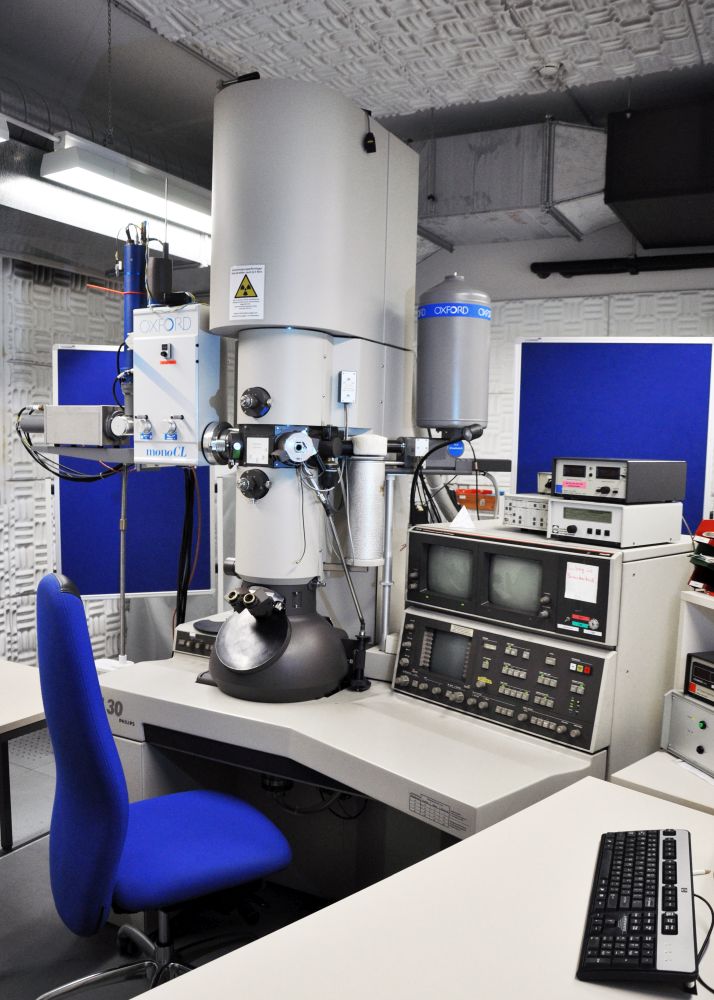
The Philips CM30 TEM/STEM is used for several in situ experiments to investigate on the one hand temperature dependent properties and mechanisms by heating and cooling experiments and on the other hand to investigate elastic and plastic properties by nanomechanical testing. Furthermore, advanced conventional techniques are performed on the CM30 like large angle convergent beam electron diffraction (LACBED) for crystallographic analyses. For high contrast applications, the imaging plates are used to obtain improved diffraction patterns.
Key specifications:
- LaB6 cathode
- High tension:150-300kV
- Twin objective lens (Cs = 2 mm)
- Point resolution (Scherzer): 0.23 nm
- 1k x 1k fast CCD camera (Tietz FastScan-F114)
- EDX detector (Oxford)
- Imaging plates
Supervisors:
| Nicolas Karpstein, M. Sc. | Phone number: +49 9131 85-70399 | Email: nicolas.karpstein@fau.de | |
| Dipl.-Chem. Robert Branscheid | Phone number: +49 9131 85-70382 | Email: robert.branscheid@fau.de | Website: http://www.em.techfak.uni-erlangen.de |
SEM/FIB Dual Beam system: FEI Helios NanoLab 660
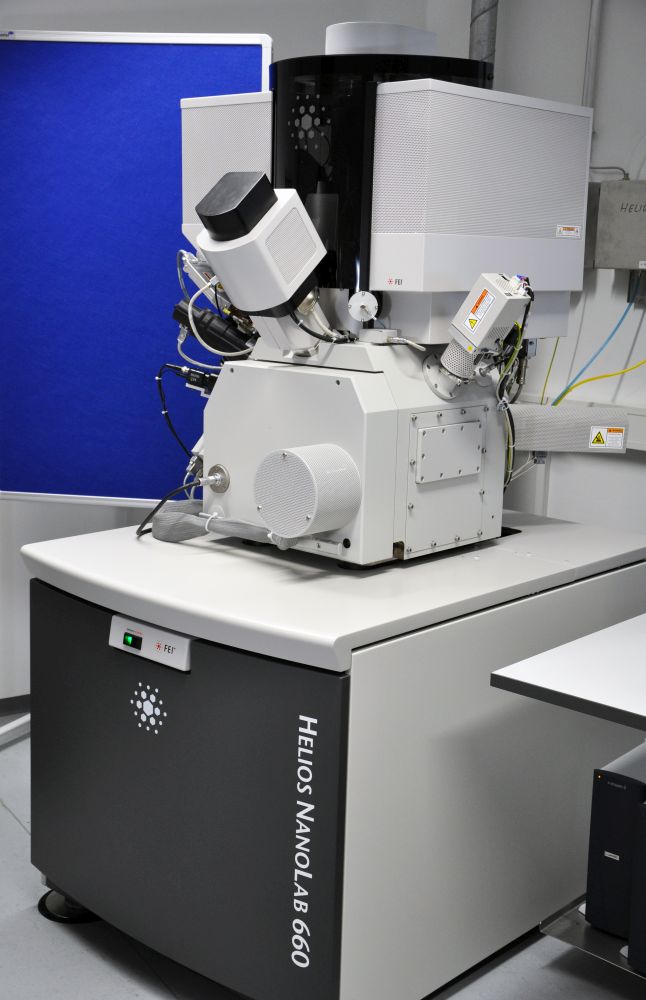
The FEI Helios NanoLab 660 Dual Beam system combines ultra-high resolution SEM imaging with extremely precise FIB milling. Having 8 different detectors, the instrument is capable of resolving a large variety of signals like secondary electrons, x-rays, and secondary ions. Using the Ga-ion FIB material can be removed with nanometer precision to prepare site-specific cross-sections, TEM lamellae or structures for mechanical tests. Three different gas injection systems are available that can be used for different purposes. Carbon and Platinum can be deposited in order to protect a surface or to do circuit editing, while XeF2 can be used for ion-less milling of certain materials. In addition, several micromanipulators are available for lift-out procedures, sample transfers and mechanical or electrical probing.
Key specifications:
- Ultra-high resolution ElstarTM electron column with monochromator
- Resolution ~1 nm at 1-30 kV
- Retractable STEM and different SE & BSE detectors for advanced imaging contrasts
- High-resolution TomahawkTM ion column
- Gas Injection System for Pt, C and XeF2
- EasyLift NanoManipulator
- Kleindiek micromanipulators
- Oxford Instruments X-MaxN EDX detector (150 mm2 SDD)
- Oxford Instruments EBSD detector
- Gatan heating stage
- In-chamber plasma cleaner
Supervisors:
| Dr.-Ing. Thomas Przybilla | Phone number: +49 9131 85-70393 | Email: thomas.przybilla@fau.de | Website: http://www.em.techfak.uni-erlangen.de |
| Michael Landes, M. Sc. | Phone number: +49 9131 85-70391 | Email: michael.landes@fau.de | Website: http://www.em.tf.fau.de |
Zeiss GEMINI SEM 560
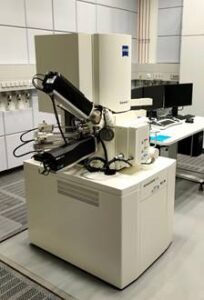
The microscope is ideally suited for low-dose, low-kV, and reduced-pressure operation for high-resolution SE/BSE/STEM imaging, electron backscattered diffraction (EBSD), energy-dispersive X-ray spectroscopy (EDXS), and transmission diffraction (TD) analysis on nanomaterials, beam sensitive-, non-conductive and magnetic samples. Highlights are in particular an ultra-sensitive direct detection camera for EBSD (Clarity Super, Ametek) and a customized setup consisting of an ultrafast direct detection camera (Timepix 3) combined with a flexible hexapod sample stage (SmarAct) for TD. This dedicated equipment enables optimized crystal structure and orientation analysis of beam sensitive nanomaterials. The TD setup is currently under development and expected to be operational within the next month.
- High-resolution electron column (Zeiss Gemini 3) with Schottky emitter and immersion-free optics
- Resolution: 0.5 nm at 15 kV, 1.0 nm at 0.5 kV
- Flexible and continuous tuning of acceleration voltage (0.02 – 30 kV) and beam current (3 pA – 20 nA)
- Sample biasing to improve resolution at low landing energies (0.7 nm at 1 kV landing energy)
- High-resolution In-lens detectors for SE and energy-selective BSE detection (EsB)
- Retractable 6-segment BSE detector with simultaneous measurement of up to 4 signals
- Retractable 7-segment STEM detector with simultaneous measurement of up to 4 signals
- Direct detection EBSD camera (Clarity Super, Ametek GmbH) with excellent low-kV (~3 kV) and low dose (<10 pA) performance, zero read out noise and distortion, single-electron sensitivity and high dynamic range
- Fast EDXS detector (Octane Elite Super, Ametek GmbH): Silicon Drift detector (SSD) with large detection area (70 mm²), high sensitivity for detecting low energy signals (e.g. Al L at 73 eV), good energy resolution (Mn Kα: 123 eV) and high throughput count rate (limit: 850k output cps at 2.0m input cps).
- Low vacuum mode (10 to 500 Pa) enabling simultaneous usage of high-resolution Inlens detectors (in conjunction with beam sleeves) up to 150 Pa (resolution: 1.0 nm at chamber pressure of 30Pa and 15 kV, 0.4 nm at chamber pressure of 30 Pa and 3 kV)
- Eucentric 6-axis sample stage
- Automatic load lock (80 mm)
- In chamber plasma cleaner
- Customized TD setup (under development) consisting of a hexapod stage (SmarAct GmbH) with eucentric tilt for precise and flexible sample positioning and an ultrafast direct detection camera (Timepix 3)
Supervisors:
| Johannes Böhmer, M.Sc. | Phone number: +49 9131 85-70398 | Email: johannes.jb.boehmer@fau.de | Website: https://www.em.tf.fau.de |
| Dr.-Ing. Thomas Przybilla | Phone number: +49 9131 85-70393 | Email: thomas.przybilla@fau.de | Website: http://www.em.techfak.uni-erlangen.de |
Phenom ProX Tabletop SEM
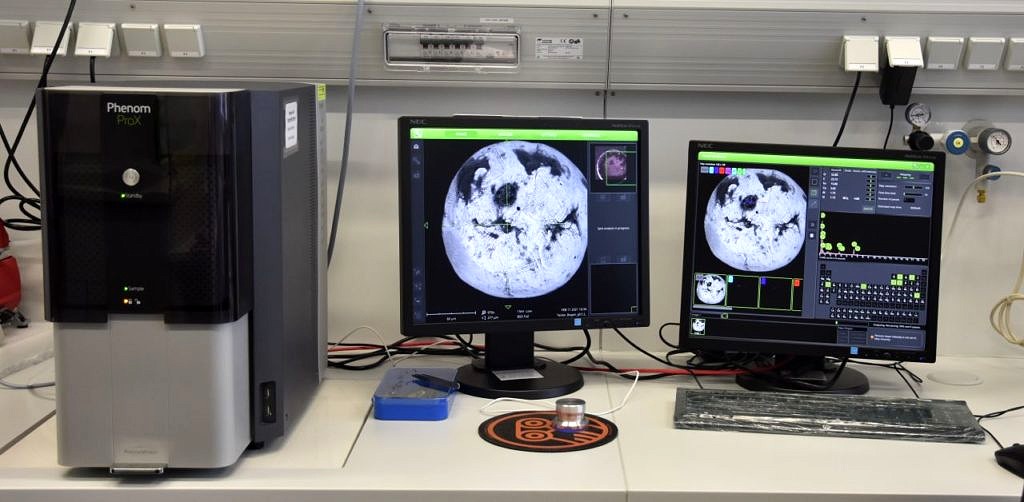
The Phenom ProX G5 Tabletop SEM is equipped with three different detectors enabling the user to take high-resolution images of the sample surface (SE-detector, four-segment BSE-detector) as well as analyzing its material composition (EDX-detector) at the same working distance. The sample loading time is very short allowing for quick imaging with minimal time spent between sample exchange. Thanks to the easy-to-use software users of any experience level can operate the device.
- SE-, BSE- and EDX-detector
- Electron optical magnification range: 70-150 000 x
- Accelaration voltage: 4,8-15 kV (default 5 kV, 10 kV and 15 kV)
- Working distance: 2-30 mm
- Maximum sample size: 2,5 cm
- Resolution at 10 kV: BSE ≤ 10 nm, SE ≤ 8 nm
- Integrated optical microscope for sample inspection and navigation (20 -135 x Zoom)
Supervisors:
| Carmen Rubach | Phone number: +49 9131 85-70392 | Email: carmen.rubach@fau.de | Website: http://www.em.techfak.uni-erlangen.de |
Zeiss Xradia 810 Ultra
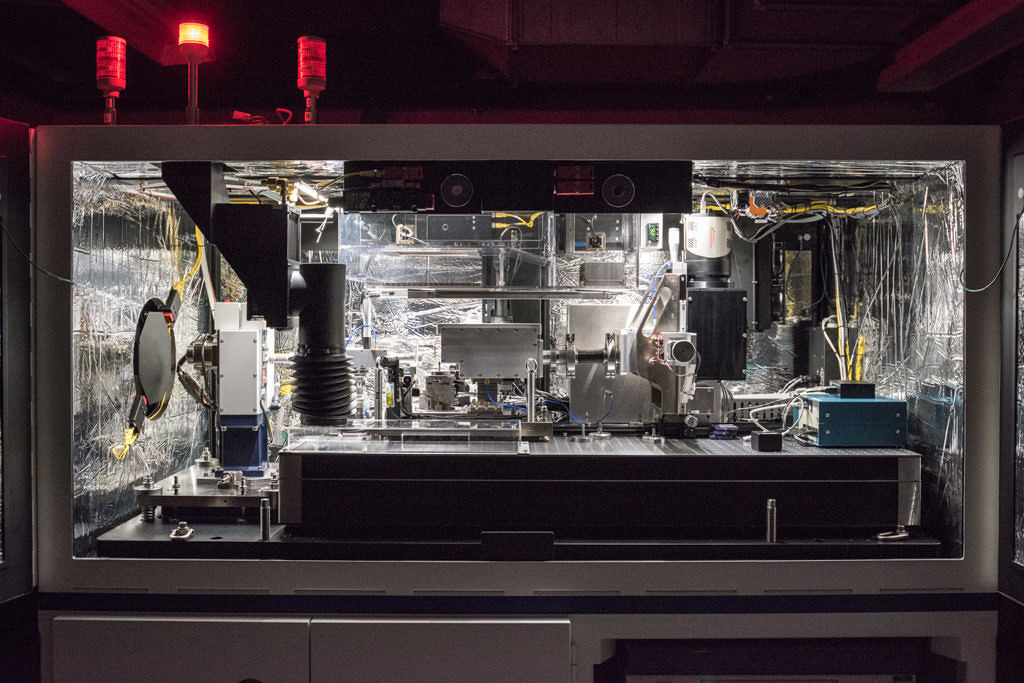
Our Xradia Ultra is a high-end X-ray microscope (XRM) providing high-resolution imaging up to (50 nm)³ as well as large field of view stacks made for three-dimensional reconstructions. With advanced optics firstly established for synchrotron setups, we obtain with this XRM equal resolutions in the laboratory. The rotating chromium anode source offers a quasi-monochromatic 5.4 keV x-ray beam due to condenser and Fresnel zone plate lens system. Common absorption imaging yield material mass contrast of small slices up to bulk specimen. In addition, the Xradia Ultra includes Zernike phase contrast visualization for porous or small mass-bandwidth samples as organic materials by edge enhancement. Furthermore, mechanic in situ experiments are enabled by a customized mounting stage for pressure, shear and strain stress. The high-end XRM closes the visualization gap between Light and Electron Microscopy in a non-destructive way.
Key specifications:
- Spatial resolution: 50-150 nm
- Field of view: 16-65 µm
- X-ray photon energy: 5.4 keV (Cr source)
- Absorption and phase contrast modes
- X-ray condenser system: Reflective ellipsoidal mirror with aperture
- X-ray objective lenses: Diffractive Fresnel zone plate objectives
- Annular Zernike phase plate
- Internal temperature control
- 1M CCD camera coupled to scintillating screen
- Rotational loading stage (> ±90°)
- Video camera
- Tomography sample holder and software
- Typical acquisition times for one 180° tilt series:
~1 day (absorption contrast), ~2-3 days (phase contrast)
Supervisors:
| Simon Carl, M.Sc. | Email: sim.carl@fau.de |
A collection TEM specimen holders are available for a variety of different experiments. Several single tilt, double tilt and rotation holders allow any orientation of the specimen inside the TEM. A vacuum transfer holder can be used for specimens sensitive to ambient air. Cooling and heating holders enable the investigation of temperature dependent properties and mechanisms like e.g. phase transitions. The MEMS based heating holders improve the performance of the TEM investigation as only a minimum area of the holder is heated controlled. The cooling holder can be used for beam sensitive specimens to improve specimen stability. For electron tomographic investigations several tomography holders are available (Single-Tilt, EDXS Single-Tilt, Dual-Axis Rotation, 360° tomography). The 360° tomography holder enables reconstructions without the missing wedge artifact. Special in situ holders like the PicoIndenter, the TEM-STM and TEM-AFM holders enable advanced in situ investigations regarding nanomechanical testing, force measurements as well as measurements of the electrical properties.
- Single tilt holders (FEI/TFS)
- Double tilt holders (FEI/TFS)
- Rotation holder (Philips)
- Vacuum transfer holder (Gatan)
- LN2 cooling holder (Gatan)
- Cryo-Tomography LN2 cooling holder (Fischione)
- Helium cooling holder (-253 °C)
- Single tilt heating holder, MEMS based (DENSsolutions)
- Double tilt heating holder, MEMS based (DENSsolutions)
- Tomography heating holder, MEMS based (DENSsolutions)
- Single-Tilt Tomography holder (FEI/TFS)
- Single-Tilt EDXS tomography holder (FEI/TFS)
- 360° Tomography holder (Fishione)
- Dual-axis rotation tomography holder (Fischione)
- PI 95 TEM PicoIndenter (Hysitron)
- TEM-STM holder (Nanofactory)
- TEM-AFM holder (Nanofactory)
As the quality of the sample is a crucial and important factor for the TEM investigation, several different machines are available for the wide range of user needs regarding the sample preparation. Mechanical methods like grinding, dimpling and polishing can be used for bulk material removal and geometrically precise polishing techniques. Ion beam instruments offer final milling as well as cleaning methods. Soft materials can be prepared in the cryo-ultramicrotome either at ambient or at cryo-temperatures. Additional equipment like wire saws, coating machines, evaporators, spin coater, ovens are available as well as a glove box, a plasma cleaner and various light microscopes.
- 2 Ion Polishing Systems (Gatan PIPS, one with low-energy ion guns and LN2 cooling)
- Various grinding machines (Struers LaboPol-21, Buehler EcoMet30)
- Semiautomatic polishing machine (Allied Multiprep)
- Low volume semi-automatic polisher (Buehler Minimet 1000)
- 2 Wire Saws (Well model 3400 and 3242)
- Precision cutter (Buehler Isomet1000)
- 2 Dimpling machines (Gatan model 656)
- Ultrasonic cutter (Gatan model 601)
- Coating machines (Korvus HEX Base 300, Baltec Med 020)
- Carbon Coater (Leica EM ACE200)
- Evaporators
- Spin coater (Laurell WS650Mz-23NPP)
- Automatic film applicator (Zehntner ZAA 2300)
- Cryo-ultramicrotome (Leica EM UC6)
- Different ovens (Binder VD53, Gero HTRH 40-250/16, Gero SR 100-650)
- Various light microscopes (Zeiss, Nikon)
- Stereo microscopes (Leica M80, S9)
- Plasma Cleaners (Fishione Model 1020 and Model 1070)
- Glove Box (GS T3)
- Tabletop ultra-centrifuge (Hermle Z36HK)
- Analytical balance (Mettler-Toledo XS204DR)
- Precision balance (Kern & Sohn PBJ 4200-2M)
- Vitrobot (FEI Vitrobot MarkIV)
Fischione’s Model 1040 NanoMill
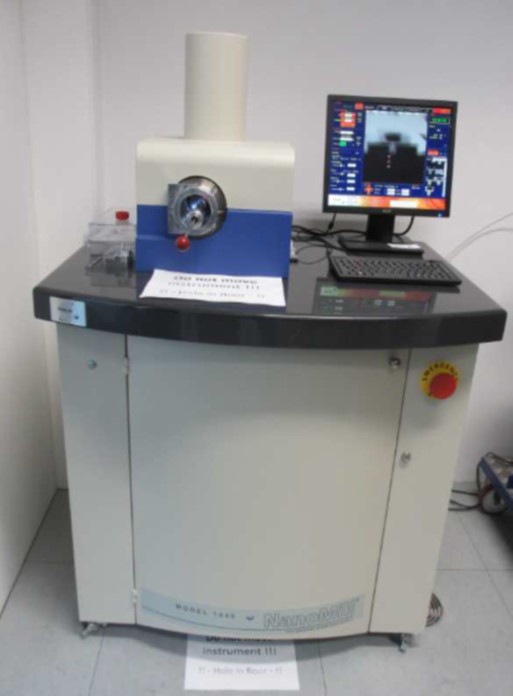
Fischione’s Model 1040 NanoMill® TEM specimen preparation system is an excellent tool for creating high-quality thin specimens needed for advanced transmission electron microscopy imaging and analysis. It is ideal for both post-FIB (focused ion beam) processing and the enhancement of conventionally prepared specimens.
3D-Micromac microPREP™ PRO laser ablation system
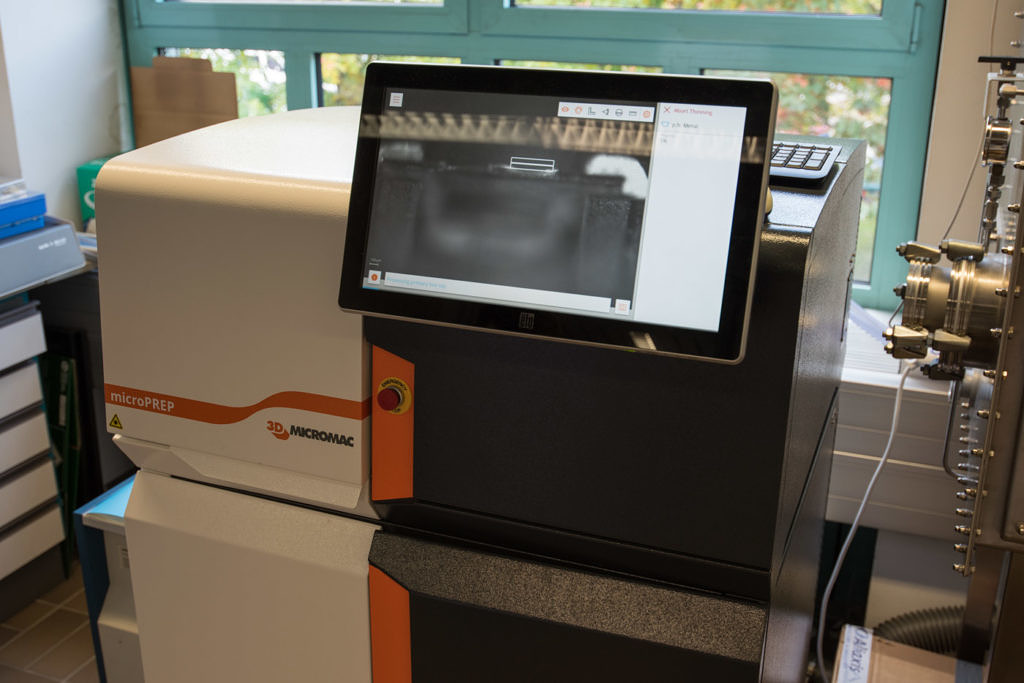
The microPREP facilitates diverse (pre)processing of samples irrespective of the type of sample material. Particularly the perforation of thin sheet materials and the preparation of structures down to the low micrometer regime can be conducted very beneficially. The laser machined workpieces can also be postprocessed then easily & time-saving with a focused ion-beam to obtain the finally desired sample geometry. For example TEM-grids implying the region of interest can be cut directly from sheet material. Moreover pillars, lamellae and further micromorphologies can be excavated out of bulk material. The device software comprises Laser-recipe classes including some standard ablation geometries and enables CAD-import for a wide range of customized sample geometries. For all the different Laser processes two fundamental Laser modes are available, which differ in the way the Laser is guided over the workpiece.
Key specifications:
- Diode pumped pico-second pulse solid state Laser (frequency doubled Nd-YAG Laser operating at 532 nm)
- Maximum Power: 3 W
- Four sample holders for cutting (e.g. TEM-grids), bulk contours (including pillars, lamellae & more), sample post thinning and rotational milling
- Workpiece sizes up to ~25 x 25 x 25 mm³
- Galvanometer scanner with a usable scanning field of ~25 x 25 mm²
- Dimension accuracy down to ~± 5 µm
- Microscope camera with a fixed 100x optical magnification and a field of view of 3.2 x 2.3 mm² for positioning of the shapes to be lasered
- Overview camera
- Compressed air jet for removal of laser-ablated material
E-beam PVD HVB 130
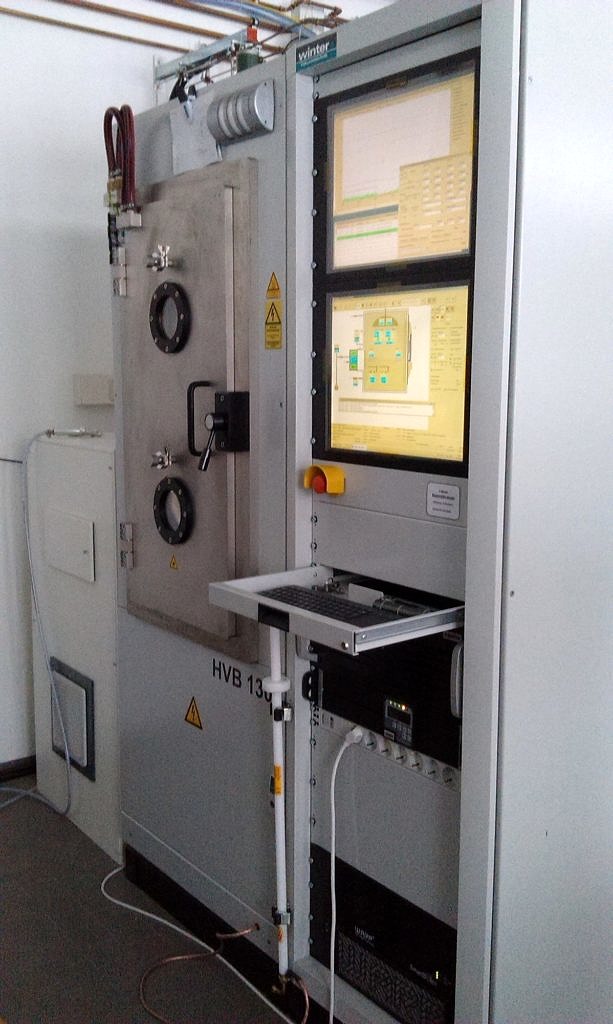
The HVB 130 by Winter Vakuumtechnik allows physical vapor deposition of thin films using electron beam evaporation. With two separate sources and each of them containing four crucibles, we can not only deposit multilayer systems with up to four different elements without venting the chamber, but also produce alloy thin films by co-evaporation of two elements using both electron sources simultaneously. Each crucible yields a maximum film thickness of ~ 150 nm with high accuracy of thickness beginning from 10 nm on. Frequently used elements are Au, Ni, Ag, Cu, Si and Al, but any element suitable for e-beam deposition can be included in our device. During deposition, the substrate can be heated up to 230°C. A O2 gas flow can be programmed between the steps to oxidize the just deposited thin film before adding the next layer. Samples are mounted on a plate with 10 cm in diameter with separate holding devices for 10 mm x 10 mm squared samples and TEM grids. Light samples can be directly taped onto the plate. There are in total four of these plates in a rotating mechanism allowing to operate just as many different recipes in one run.
Key specifications:
- Two sources for co-evaporation
- 4 crucible pockets per electron source
- Automatic sample stack for parameter variation
- Substrate heating up to 230°C
- Optional gas flow (O2) via MFC
- Flexible recipe integration for automatization
Rapid thermal annealing (RTA) furnace
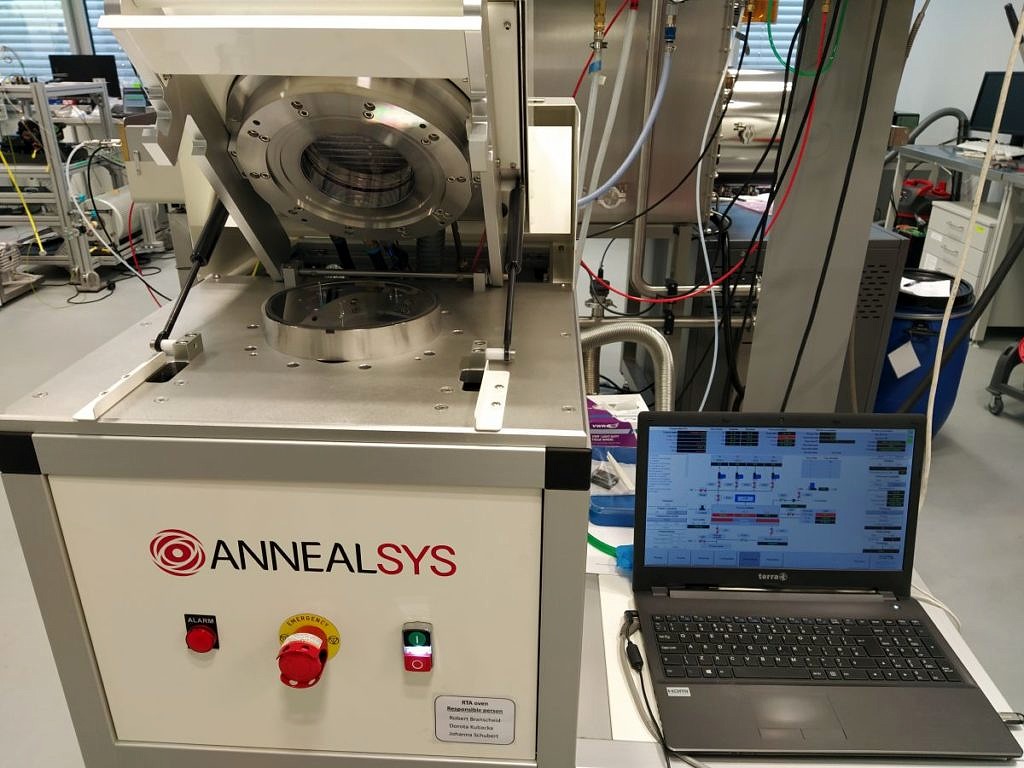
Rapid Thermal Annealing (RTA) furnace AS-One 100 from Annealsys is an advanced system commonly used in a semiconductor manufacturing process, designed for short-duration and high-temperature annealing. The heating is realized by tubular halogen lamps located behind a quartz window, which allows precision temperature control. RTA enables fast and precise heating and cooling ramp control up to 200 ⁰C/s. Moreover, different gas mixtures (argon, oxygen, hydrogen and nitrogen) and a wide range of pressure (from atmospheric to high vacuum) can be applied. Substrate material with 10 cm diameter is placed on three quartz pins, which reduces the thermal transfer. We use Si or Si3N4 wafer for bulk samples or silicon carbide coated graphite susceptor with a lid for thin and smaller samples. The temperature measurement is realized by pyrometer below the substrate. Therefore, it is guaranteed to receive the signal from the wafer, instead of the lamps. The AS-One system has a stainless steel cold wall process chamber for better process reproducibility and higher cooling rates. RTA is a powerful tool with various applications, which already extend beyond semiconductors, like solar cell fabrication or investigation of early stages of high-temperature oxidation. We successfully use it for the dewetting experiments (AuNi system) and oxidation studies of Ni- and Co-based superalloys.
Key specifications:
- Temperature range: RT to 1250°C
- Heating rate up to 200°C/s
- Cooling rate up to 200°C/s
- Gas mixing capability with mass flow controllers (O2, N2, Ar, H2)
- Vacuum range: Atmosphere to 10-6 Torr
- Full PC control with Windows compatible software
- Possibility of creating complex and multi-step heating recipes
Coordinator of facilities

Dr. Benjamin Apeleo-Zubiri, Akad. Rat
91058 Erlangen
- Phone number: +49 9131 85-70394
- Email: benjamin.apeleo.zubiri@fau.de
- Website: http://www.em.techfak.uni-erlangen.de

Dr.-Ing. Thomas Przybilla
91058 Erlangen
- Phone number: +49 9131 85-70393
- Email: thomas.przybilla@fau.de
- Website: http://www.em.techfak.uni-erlangen.de
